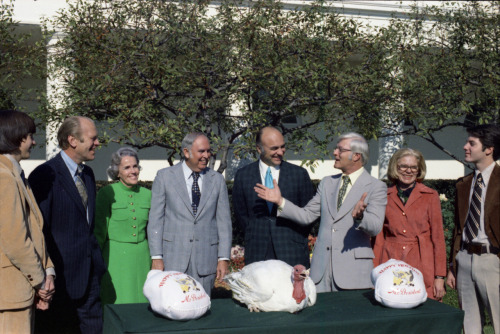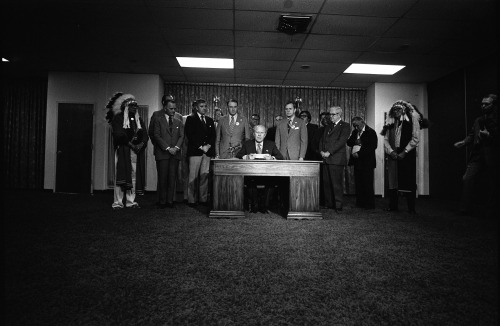#president gerald r ford

We were sorry to learn of the passing of Apollo 11 astronaut and command module pilot Michael Collins at age 90. Collins served as Director of the Smithsonian’s National Air and Space Museum from 1971-1978. He gave President Ford a tour of the exhibits following the museum’s dedication on July 1, 1976. Watch footage of the tour here: https://youtu.be/uffSS-XcAcQ
Image: Museum Director Michael Collins Giving President Gerald R. Ford and Vice President Nelson A. Rockefeller a Tour of the National Air and Space Museum, 7/1/1976 (National Archives Identifier 45644211)
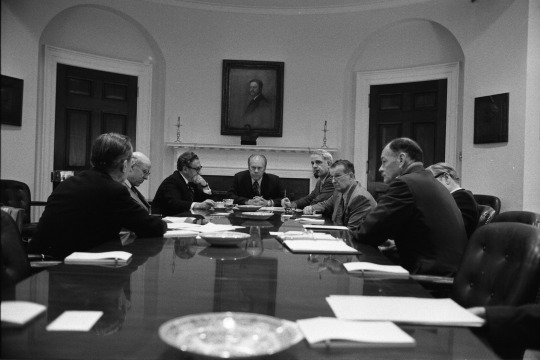
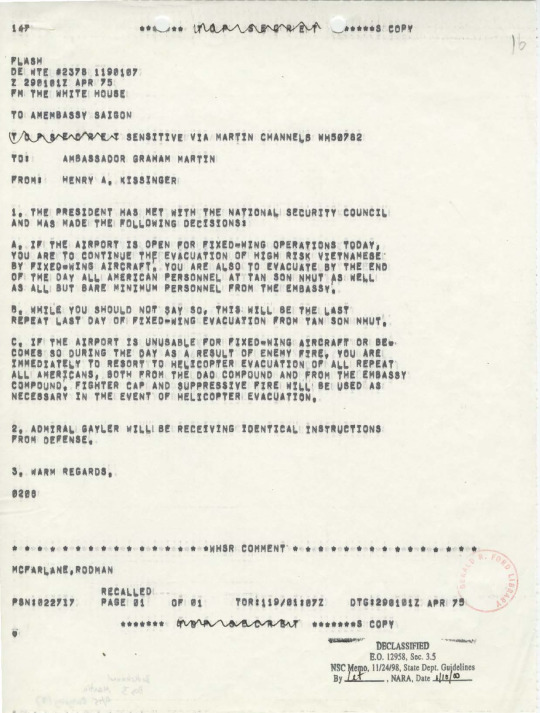
President Ford convened the National Security Council in the evening of April 28, 1975, to discuss the final evacuation of Saigon, Vietnam.
Secretary of Defense James Schlesinger, Secretary of State Henry Kissinger, Joint Chief of Staffs Chairman General George Brown, Director of Central Intelligence William Colby, and Deputy National Security Adviser Lt. General Brent Scowcroft reported on conditions around the city and the advance of North Vietnamese troops.
The meeting ended at 8:08 p.m. with the President and NSC having decided to continue the evacuation by fixed-wing aircraft at Tan Son Nhut airport for as long as possible. The helicopter lift would begin once the other planes could no longer get in.
President Ford continued to monitor developments in Saigon with Secretary Kissinger. Within a few hours North Vietnamese shelling of Tan Son Nhut airport and debris on the runways prevented military transport planes from landing there. Around 11:00 p.m. President Ford ordered the final evacuation.
Secretary Kissinger sent a telegram to Ambassador Graham Martin to inform him of the President’s decision regarding the evacuation. Over the course of sixteen hours, helicopters removed over 6,500 U.S. and South Vietnamese personnel from the city. Saigon fell under the control of North Vietnamese forces on April 30, 1975.
Images: President Gerald R. Ford Presiding Over a National Security Council Meeting Regarding the Situation in South Vietnam, 4/28/1975 (National Archives Identifier 23898449)
Telegram from Henry Kissinger to Ambassador Graham Martin Regarding President Gerald R. Ford’s Decision on the Evacuation of Saigon, South Vietnam, 4/29/1975 (National Archives Identifier 7367498)
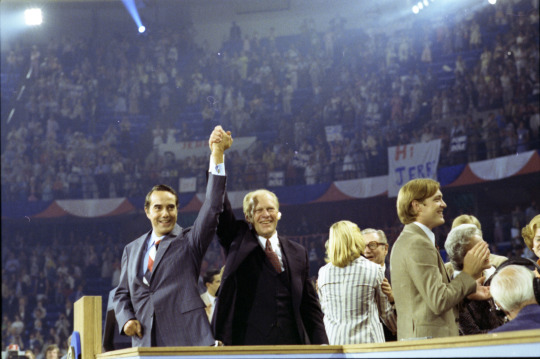
Our condolences go to the family of Senator Robert Dole, who passed away yesterday. Senator Dole and President Ford had a close working relationship and friendship throughout their government service. They served together in the House of Representatives for eight years before Dole was elected to the Senate in 1968.
Most notably, President Ford selected Dole as his Vice President for the 1976 campaign. “When I looked over the list of people that I wanted to be my teammate in the months ahead…Bob Dole was the guy,” he told the people of Russell, Kansas, at a rally in Dole’s hometown following the Republican National Convention. Ford noted that Dole “has a personal contact” with his colleagues and constituents, and “understands the problems of local communities and their relationship with the Federal Government.”
After their loss, Dole continued to serve in the Senate, becoming a leader of the chamber’s Republicans and serving as Majority Leader twice. He resigned from the Senate while running for President in 1996. President Ford actively campaigned on his behalf. After losing the election Dole retired from politics but remained active in other areas, including serving as national chairman of the campaign to raise money for the National World War II Memorial.
Learn more through selected documents related to Bob Dole:
President Ford’s press conference announcing Bob Dole as his running mate, 8/19/1976: https://www.fordlibrarymuseum.gov/library/exhibits/campaign/024800000-001.pdfPresident Ford’s remarks at a rally with Bob Dole in Russell, Kansas, 8/20/1976: https://www.fordlibrarymuseum.gov/library/document/0248/whpr19760820-007.pdfLetter from Bob Dole to President Ford following their loss in the 1976 election, 12/3/1976: https://www.fordlibrarymuseum.gov/library/document/0442/121641531.pdf
Image: President Ford and running mate Bob Dole standing together following Ford’s speech accepting the Republican nomination at the 1976 Republican National Convention in Kansas City, Missouri, 8/19/1976 (White House Photograph B1197-28A)
Happy Thanksgiving!
The National Thanksgiving Turkey Presentation is a ceremony that takes place at the White House every year shortly before Thanksgiving. Here representatives from the National Turkey Federation present President Ford with a Thanksgiving turkey on November 11, 1974.
From left: Jim Shepard; President Ford; Mrs. Shepard; W.H. Shepard, Jr., President of the National Turkey Federation; Clayton Yuetter, Assistant Secretary of Agriculture; Lew Walts, Executive Secretary of the National Turkey Federation; Mrs. Walts; and Spencer Walts.
Post link
Since the 1990s November has been designated as Native American Heritage Month. A precursor to this observance was Native American Awareness Week in 1976.
Jerry Elliott High Eagle, a member of the Osage Nation who worked for NASA, served as chair of the effort to have Congress pass legislation recognizing October 10-16, 1976, as Native American Awareness Week. While some states and cities had local observances, he believed the nation’s 200th birthday was a time for indigenous history to be celebrated nationwide.
“This legislation is positive and in concert with the desires and wishes of Native Americans everywhere. Therefore, it becomes appropriate and important that this proclamation be brought to public notice during the bicentennial year at a time when the whole instinctive movement of all American people is for a deeper footing in their native soil,” Elliott wrote to Dr. Ted Marrs, Special Assistant to the President for Indian Affairs, in April 1976. “At this important time in American history, let’s make it even more significant by having our Indian background, culture and current contributions brought to the forefront.”
The resolution text that Elliott proposed went before Congress and was ultimately passed as Senate Joint Resolution 209. President Ford issued a proclamation recognizing Native American Awareness Week during a trip to Lawton, Oklahoma, on October 8, 1976. Elliott was in the audience at the signing ceremony, which was attended by leaders from tribal nations including the Cherokee, Seminole, Choctaw, Osage, Kiowa, Comanche, Wichita, Caddo, Delaware, and Fort Sill Apache.
Read the text of SJR 209, Native American Awareness Week, in the Legislation Case File here: https://www.fordlibrarymuseum.gov/library/document/0055/1669616.pdf
Read the Presidential proclamation for Native American Awareness Week, 1976 here: https://www.fordlibrarymuseum.gov/library/document/0159/1670045.pdf
Image: President Ford Delivering Remarks Before Signing a Proclamation Designating Native American Awareness Week, 1976 at the Montego Bay Hotel in Lawton, Oklahoma, 10/8/1976 (White House Photograph B1789-15A)
Post link


A group of distinguished American Olympians who participated in the 1976 Summer Olympic Games and members of the Commission on Olympic Sports visited the White House on August 5, 1976. President Gerald R. Ford greeted these American champions who had recently earned 94 medals in Montreal, Canada, in the East Garden of the White House.
“You won gold, silver and bronze. Some of you set records,” President Ford remarked to the Olympic Team. “You gave your utmost effort, and on behalf of all Americans, we were very, very proud of you.” In his typical sense of humor, he also noted, “Let me say that you were not alone in your feats of stamina and strength. Millions of Americans, including myself, are now recovering from the marathon sessions with their TV sets.”
After finishing his remarks, members of the Olympic Team and the U.S. Olympic Committee presented President Ford with this glass paperweight. Etched on the irregular shaped glass is the U.S. Olympic Committee seal, which consists of an image of the Olympic Torch rising above the United States shield. The paperweight is stored in a black snakeskin-textured box, lined with red velvet.
Images: Glass paperweight presented to President Ford by members of the Olympic Team and the U.S. Olympic Committee; President Ford addresses members of the 1976 U.S. Olympic Team and others in the East Garden prior to presenting the Presidential Medal of Freedom to Jesse Owens, 8/5/1976 (White House photograph B0963-08)

